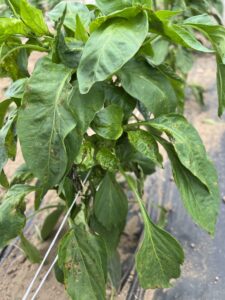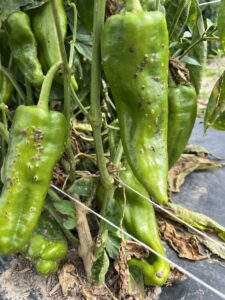The first symptom of bacterial spot of pepper that is usually noticed is the lesions on the leaves. These lesions are irregular to round in shape and brown and are associated with chlorosis. Lesions are usually water-soaked (Figure 1). In severe cases, the fruit may be affected. The lesions on fruit are often raised (Figure 2). Additional photos of bacterial spot of pepper can be found here https://vegcropshotline.org/bacterial-spot-of-pepper/.

Figure 1. Bacterial spot of pepper causes irregular to round lesions on leaves (Photo by Petrus Langenhoven).
Bacterial spot of pepper is favored by temperatures 75 to 86oF with plenty of rain or overhead irrigation. High relative humidity also favors disease development. The pathogen is spread by wind-driven rain, which splashes the bacteria and forces them into adjacent leaves.
The pathogen that causes bacterial spot of pepper may be seed-borne. For this reason, transplants should be inspected for symptoms carefully when grown or when received.
Management of bacterial spot is best accomplished through host resistance. Choose pepper varieties that are listed as resistant to several different races of bacterial spot. However, host resistance may be limited in specialty peppers.
Copper products are the primary management product for bacterial spot control of pepper. While strains of bacterial spot of tomato are largely resistant to copper, it is not clear if strains that cause bacterial spot of pepper are also resistant to copper. Strains that cause bacterial spot on these two hosts do not cause disease on the opposite host.
Other products that can be used to manage bacterial spot of pepper include Actigard®. Actigard® is labeled at 0.3-.75 oz per acre. Begin the applications at the lower rate and increase the rate as the canopy increases in size. Actigard works by turning on host defense reactions. For this reason, do not use the product when the peppers are under stress, for example by drought.
I have had some success using the product Lifegard® for bacterial spot of tomato. It is a microbial product and works similarly to Actigard® to turn on plant defense reactions. It may be listed in some organic certification plans. (it is listed by omri.org). Take care not to use Lifegard® with copper or hydrogen peroxide products because these products may kill the beneficial bacteria in the product. Read the label carefully for other details. Other products that are labeled for bacterial spot of pepper include Regalia®, Serenade Opti®, and Tanos®. Streptomycin products may be used in the greenhouse only.
More details are listed in the Midwest Vegetable Production Guide (mwveguide.org). And always read the labels carefully.
